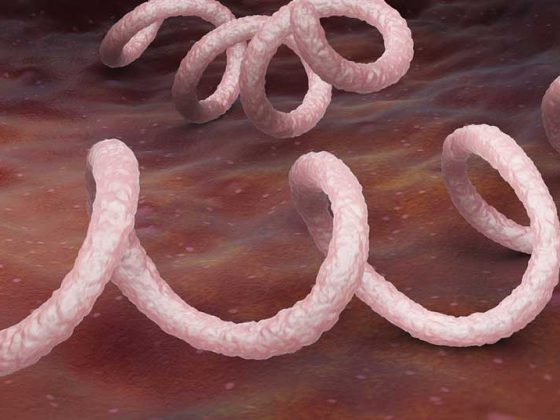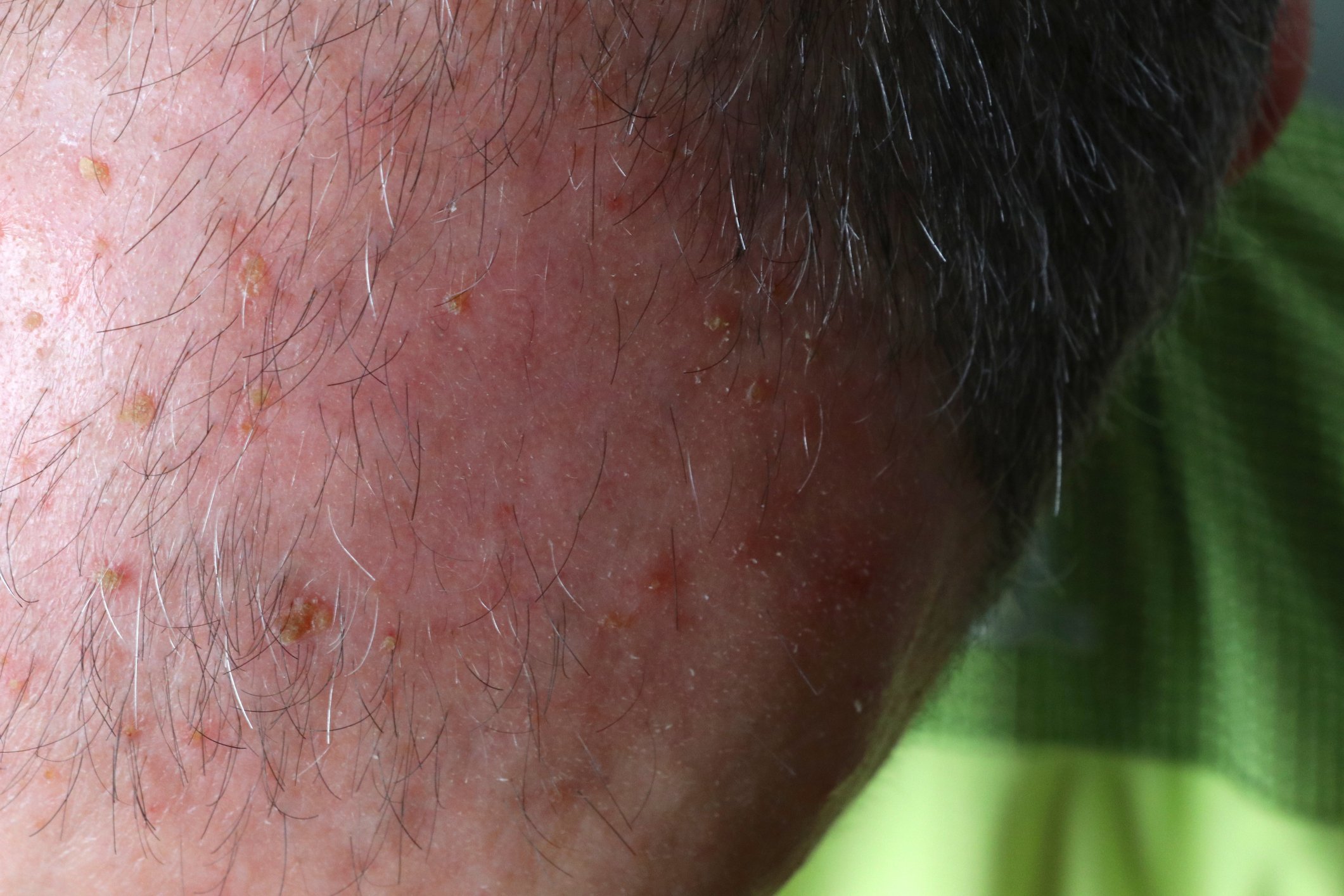In addition to echinacea purpurea, the most commonly used medicinal plant for treating symptoms of flu-like infections, there are other herbal preparations that have shown efficacy against corresponding symptoms in clinical studies. In addition to the extract EPs 7640 from Pelargonium sidoides, there are two other preparations in Switzerland that are reimbursed by basic health insurance.
When one speaks of phytotherapy for the treatment of symptoms of flu-like infections, one rightly thinks first of the coneflower, Echinacea purpurea (or also E. angustifolia or E. pallida). This medicinal plant is at the forefront of herbal treatment of mostly viral upper respiratory tract infections. In pharmacies, such preparations are very often requested, and many doctors prescribe echinacea preparations against the symptoms of influenza, which often occurs in the cold seasons.
However, it is less known that there are other medicinal plants besides echinacea that are suitable for the treatment of corresponding diseases. In Switzerland, there are some preparations for the treatment of respiratory infections.
In addition to magistral mixtures of tinctures and mother tinctures, which are often reimbursed by basic insurance, there are also finished preparations that are also reimbursed. Since this plays a major role in medical practice, three preparations are presented here that are included in the so-called list of specialties. Thus, they are among the mandatory benefits of all health insurance companies.
EPs 7630 – the extract of Pelargonium sidoides
The standardized extract EPs 7640 is an extract developed in Germany from the African medicinal plant Pelargonium sidoides, from the geranium family (Fig. 1) . The natives of southern Africa have used this medicinal plant for various applications for a long time.
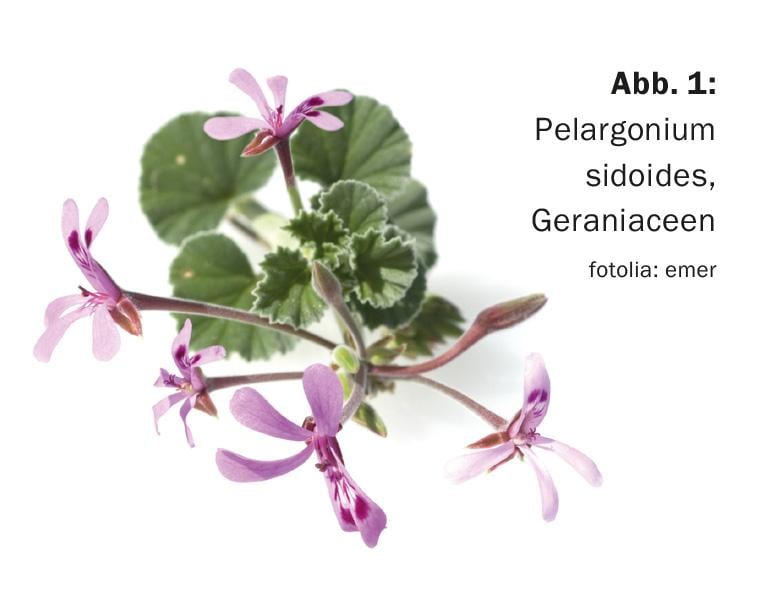
The therapeutically important ingredients are polyphenols and coumarins. EPs 7640 supports anti-infective defenses in the acute phase and at the same time has immune-modulating properties by releasing TNF-alpha and NO, stimulating interferon synthesis, and activating killer cells [1].
The extract EPs 7630 (Tab. 1) produced from the root is used in part to treat various symptoms associated with flu-like infections, such as bacterial sinusitis, acute bronchitis, or simply cold-related symptoms. The extract is approved in Switzerland only for acute bronchitis.
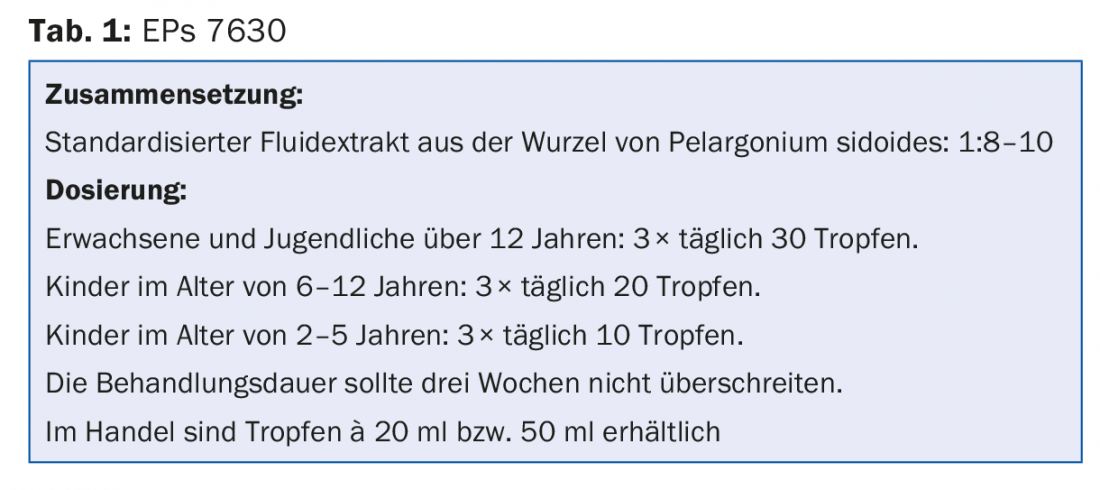
Several studies have documented efficacy of Pelargonium extract: Matthys et al. [2], for example, used tablets with different dosages (10 mg; 20 mg; 30 mg) of EPs 7630 for seven days in acute bronchitis in a three-arm placebo-controlled randomized trial. In the change in symptom score as well as in the assessment by the investigators and the patients themselves, all three doses proved to be significantly superior to placebo. Other studies showed similar results for acute bronchitis or simple colds, the majority with significant evidence, even in children [3,4].
A combination of thyme and primele extract
Another purely herbal preparation for the treatment of acute bronchitis consists of a combination of a thyme and a primele extract (Tab. 2) . Both medicinal plants have a long folk medicine tradition in the treatment of cough. Thymus vulgaris L., the thyme, from the labiates family, is known since ancient times and was also mentioned by Hildegard von Bingen as a medicinal plant. Thyme is rich in essential oils that have antibacterial and antiviral properties and can be used in upper respiratory tract infections, such as acute bronchitis.
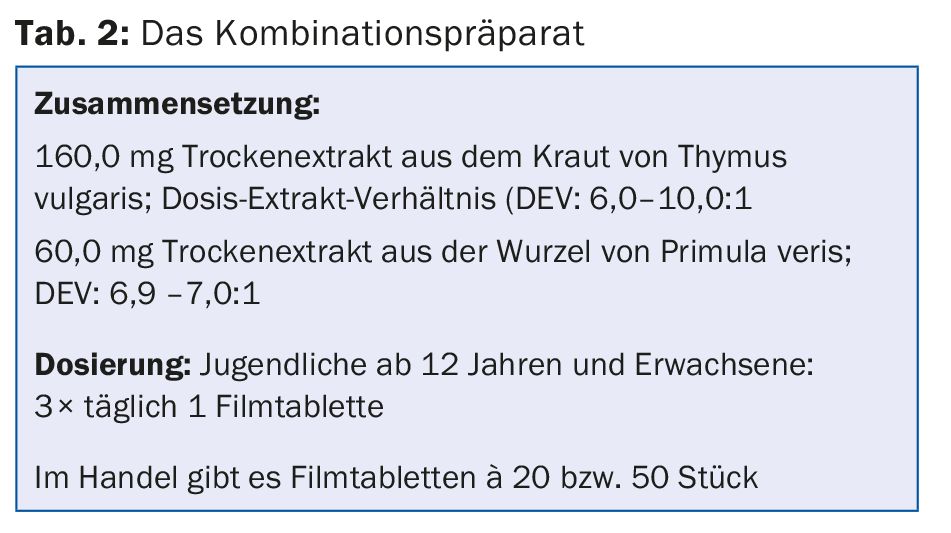
Primrose, also known as cowslip, Primula veris, from the primrose family, has saponins, flavonoids and essential oil as its efficacy-determining ingredients. These give the medicinal plant efficacy against productive cough and acute bronchitis.
In 2007, a randomized, double-blind, placebo-controlled trial appeared documenting efficacy of this combination drug [5]. The study was conducted in adult patients diagnosed with acute bronchitis who had suffered from an expectorant cough with incomplete expectoration for at least two days and had a bronchitis severity score of at least five. Patients received one tablet of the combination drug or placebo three times daily for eleven days. The number of cough attacks (primary outcome variable) determined from the seventh to the ninth day of treatment decreased significantly compared to placebo (p<0.0001). A 50 percent reduction in cough attacks was achieved significantly faster in the verum group than in the placebo group (verum: on day five; placebo: on day seven). Furthermore, the bronchitis severity score decreased significantly faster in the verum group than in the placebo group, and the investigators also identified a significantly greater number of responders.
The treatment was very well tolerated by the subjects. There was no difference in the frequency of significant or serious adverse events between the two treatment groups.
An old classic revived
The third herbal preparation against symptoms of flu infection is based on an old folk medicine recipe, the effectiveness of which has been clinically confirmed in this century. It is the medicinal plant mixture BNO-101, which is a combination of various dried, powdered medicinal plants (Tab. 3).
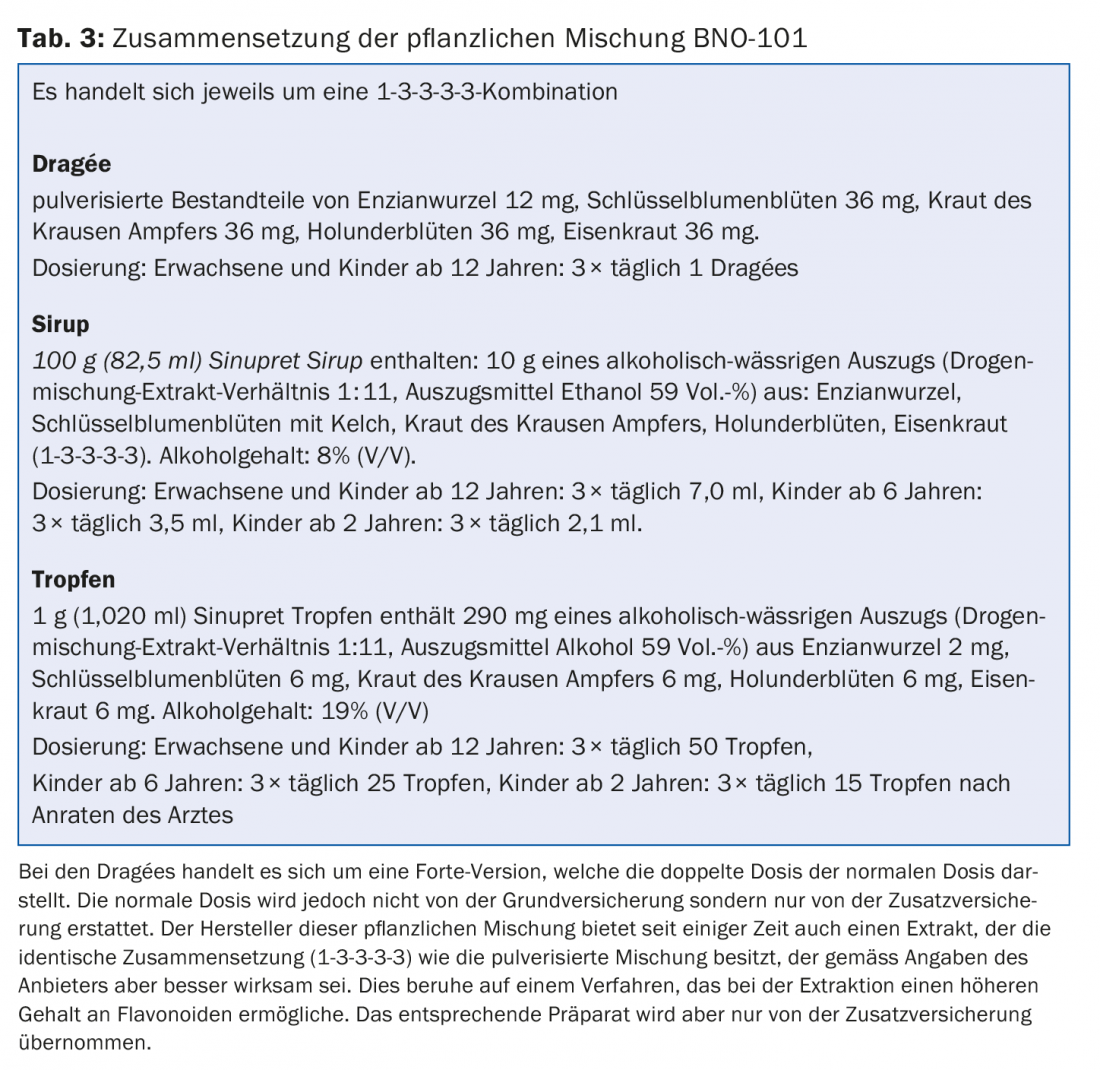
The mixture BNO-101 also showed efficacy in various studies. Symptom improvement in children two years of age and older with sinusitis was observed with administration of the drop form and the weaker dose of the dragées in a noninterventional study published in 2004 [6]. After an average of 12 days of treatment, the vast majority of children showed improvement in symptoms such as viscous and thin nasopharyngeal secretions as well as obstructed nasal breathing, headache, cough, and hoarseness.
In 2006, a systematic review [7] of clinical trials appeared in Researching Complementary Medicine. Six RCT (randomized controlled trials) were evaluated, involving a total of 900 patients. Two studies (both add-on to antibiotic therapy) were found to be significantly more effective than placebo (p<0.05). In two studies, partly add-on to antibiotics, BNO-101 was compared with ambroxol and proved to be equivalent or even superior in chronic cases. In two further studies, the comparative preparations were N-acetyl-cysteine on the one hand and Myrtol on the other; again, no difference was found.
Two other studies published in 2013 and 2015 [8,9] showed similar results.
Summary
In addition to the echinacea-based leader product for treating symptoms of flu-like acute bronchitis, there are a number of other medicinal plants that are also suitable for treating such symptoms. In this context, special mention should be made of the extracts Eps 7630 (Pelargonium sidoides), a combination preparation consisting of dry extracts of thyme and primrose, and the mixture BNO-101 prepared from five medicinal plants, which can also be used in acute sinusitis. Various clinical studies show efficacy of these preparations in the above indications.
Notes:
- Brand names in Switzerland: EPS 7640: Kaloba®.
- Combination preparation of thyme/Primel: Bronchipret®.
- BNO-101: Sinupret®
Literature:
- Schapowal A: Phytotherapy in acute maxillary sinusitis, phytotherapy 2006(5); 6: 9-11.
- Matthys H, et al: Efficacy and tolerability of EPs 7630 tablets: a ran in adults suffering from acute bronchitis with productivedomised, double-blind, placebo-controlled dose-finding study with a herbal drug preparation from Pelargonium sidoides, Curr Med Res Opin 2010; 26(6): 1413-1422.
- Lizogub VG, Riley DS, Heger M: Efficacy of Pelargonium sidoides preparation in pa-tients with the common cold: a randomized, double blind, placebo-controlled clinical trial. Explore 2007; 3(6): 573-584.
- Kamin W, et al:Treatment of acute bronchitis with EPs 7630: randomized, controlled trial in children and adolescents. Pediatr Int 2012; 54(2): 219-226.
- Kemmerich B: Evaluation of efficacy and tolerability of a fixed combination of dry extracts of thyme herb and primrose root in adults suffering from acute bronchitis with productive cough: A prospective, double-blind, placebo-controlled multicenter clinical trial, Drug Research 2007(9); 57: 607-615.
- Biebach K, Kramer A: Effective treatment of rhinosinusitis in children, paed – Praktische Pädiatrie 2004; 10: 333-336.
- Melzer J, et al: Systematic review of clinical data with BNO-101 (Sinupret) in the treatment of sinusitis, Forsch Komplementärmed 2006(2); 13: 78-87.
- Eichel A, et al: A proespective, controlled study of SNS01 (ectoin nasal spray compared to BNO-101 (phytotherapeutic dragées) in patients with acute rhinosinusitis, Curr Med Res Opin 2013(7); 29: 739-746.
- Passali D. et al: A prospective open-label study to assess the efficacy and safety of a herbal medicinal product (Sinupret) in patients with acute rhinosinusitis, ORL J Otorhinolaryngol Relat Spec 2015(1); 77: 27-32.
HAUSARZT PRAXIS 2017; 12(11): 3-5




